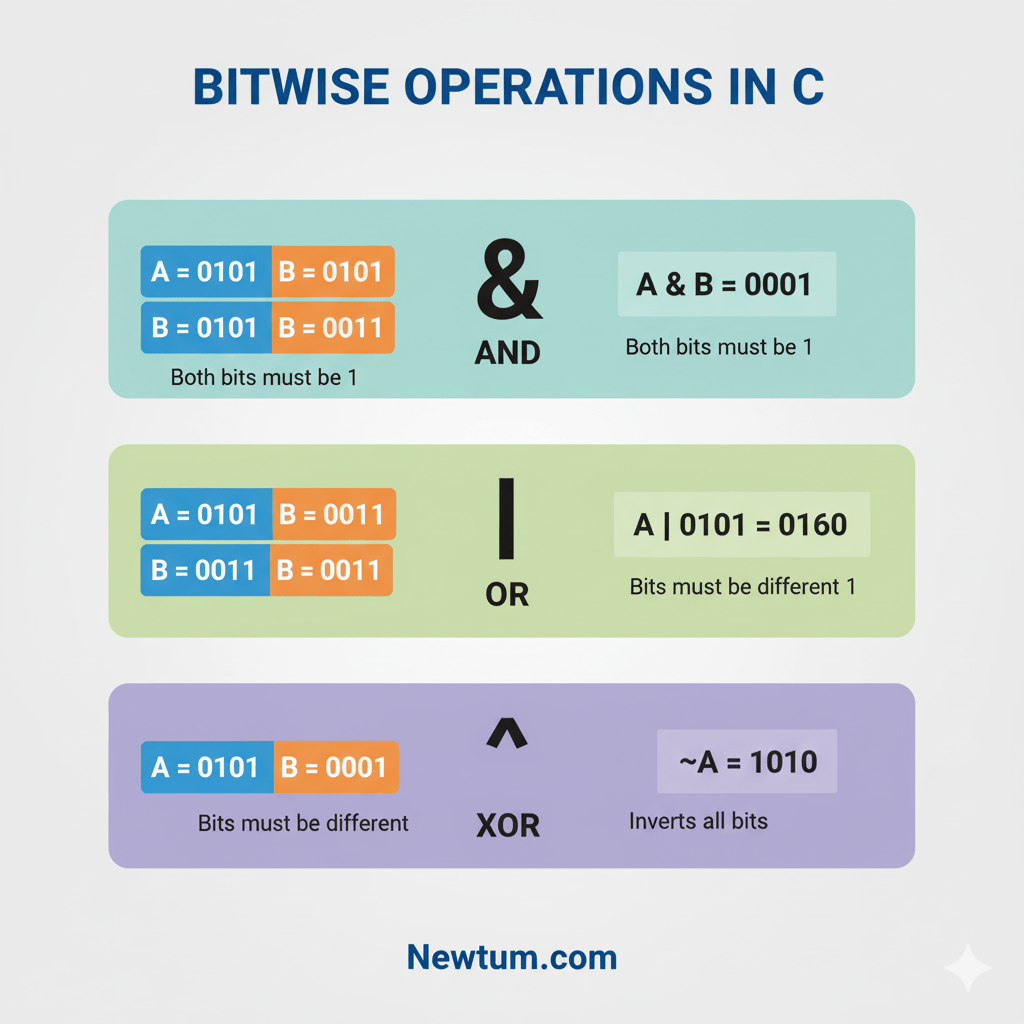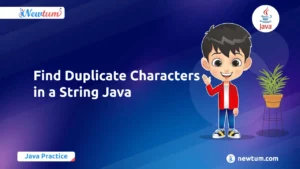Bitwise operators in C allow direct manipulation of bits within data types, enabling efficient low-level operations. They’re crucial for tasks like system programming, cryptography, and performance optimization.
In today’s tech landscape, understanding bitwise operations is vital for developers working with hardware interfaces, embedded systems, or performance-critical applications. These operators provide a means to perform operations at the bit level, offering precision and speed.
Key Takeaways of Bitwise Operators in C
- AND (
&): Sets bits to 1 if both bits are 1. - OR (
|): Sets bits to 1 if at least one bit is 1. - XOR (
^): Sets bits to 1 if bits are different. - NOT (
~): Inverts all the bits. - Left Shift (
<<): Shifts bits to the left, filling with 0s. - Right Shift (
>>): Shifts bits to the right, filling with 0s or sign bits.
What Are Bitwise Operators?

Bitwise operators are special operators in C that work directly on the binary representation of integers. Unlike arithmetic operators that work on whole numbers, bitwise operators manipulate each individual bit of a number.
For example, the number 5 in binary is 0101, and 3 is 0011. Using bitwise operators, you can perform operations like AND, OR, XOR, NOT, and shifts to manipulate these bits directly.
Why this matters:
- Bitwise operations are very fast, often faster than arithmetic operations.
- They are widely used in system programming, embedded systems, networking, and hardware-level coding.
- They allow you to control memory and flags efficiently, making your programs more optimized.
How Do Bitwise Operators Work in C?
C provides six main bitwise operators:
- AND (
&) – Compares each bit of two numbers. Returns1if both bits are 1, else0.
Example:5 & 3 → 0101 & 0011 → 0001 (1) - OR (
|) – Compares each bit of two numbers. Returns1if at least one bit is 1.5 | 3 → 0101 | 0011 → 0111 (7) - XOR (
^) – Compares each bit. Returns1if bits are different, else0.5 ^ 3 → 0101 ^ 0011 → 0110 (6) - NOT (
~) – Flips all bits (0 becomes 1, 1 becomes 0).~5 → ~0101 → 1010 (in 4-bit representation) - Left Shift (
<<) – Moves bits to the left by a specified number of positions. Vacated bits are filled with0.5 << 1 → 0101 << 1 → 1010 (10) - Right Shift (
>>) – Moves bits to the right. Vacated bits are filled with0(for unsigned) or sign bit (for signed).5 >> 1 → 0101 >> 1 → 0010 (2)
Pro Tip: Use bitwise operators in C when you want high performance or memory-efficient code.
When Should You Use Bitwise Operators?
Bitwise operators are particularly useful in scenarios where low-level control and speed are important. Some common use cases:
- Setting, Clearing, or Toggling Bits
- For example, in embedded systems, each bit of a register may represent a hardware feature. You can turn features ON/OFF efficiently using bitwise operators.
status |= 1 << 2; // Set 3rd bit status &= ~(1 << 2); // Clear 3rd bit status ^= 1 << 2; // Toggle 3rd bit - Checking Bit Patterns
- Useful in flags, masks, or permissions systems.
if (status & (1 << 2)) { /* bit is set */ } - Fast Arithmetic Operations
- Multiplying or dividing by powers of 2 can be done using shifts:
int result = num << 1; // Multiply by 2 int result = num >> 1; // Divide by 2 - Optimizing Performance
- Bitwise operations are faster than arithmetic in many low-level applications.
- Cryptography and Encryption
- XOR (
^) is widely used in simple encryption algorithms to scramble data.
- XOR (
Pros & Cons of Bitwise Operators in C
Bitwise vs. Arithmetic Operators
| Feature | Bitwise Operators | Arithmetic Operators |
|---|---|---|
| Operation Level | Bit-level | Value-level |
| Performance | Faster | Slower |
| Use Cases | Flags, Masks | General Calculations |
| Readability | Lower | Higher |
Understanding Bitwise Operators in C
c
#include
int main() {
unsigned int a = 60; // 60 = 0011 1100
unsigned int b = 13; // 13 = 0000 1101
int result = 0;
// AND Operator
result = a & b;
printf("Result of a & b = %d
", result);
// OR Operator
result = a | b;
printf("Result of a | b = %d
", result);
// XOR Operator
result = a ^ b;
printf("Result of a ^ b = %d
", result);
// NOT Operator
result = ~a;
printf("Result of ~a = %d
", result);
// Left Shift Operator
result = a << 2;
printf("Result of a << 2 = %d
", result);
// Right Shift Operator
result = a >> 2;
printf("Result of a >> 2 = %d
", result);
return 0;
}
Explanation of the Code
Let’s break down what’s happening in the code:
- Two unsigned integer variables, `a` and `b`, are declared and assigned the values 60 (0011 1100 in binary) and 13 (0000 1101 in binary), respectively.
- The AND operator (`&`) compares each bit of `a` and `b`, returning a new value with a `1` for each position where both bits are `1` (12 in this case).
- The OR operator (`|`) checks each bit of `a` and `b`, setting them to `1` if either operand has a `1` in that position (61 here).
- The XOR operator (`^`) finds where the bits differ to return a `1` (result: 49).
- The NOT operator (`~`) flips all bits of `a`, changing `1`s to `0`s and vice versa (~a results in -61 due to two’s complement representation).
- Finally, the left shift (`<<`) and right shift (`>>`) operators move bits around, either doubling or halving the value, respectively. Here, `a << 2` yields 240, and `a >> 2` gives 15.
Output
Result of a & b = 12
Result of a | b = 61
Result of a ^ b = 49
Result of ~a = -61
Result of a << 2 = 240
Result of a >> 2 = 15Real-Life Uses of Bitwise Operators in C
- Network Data Handling by Cisco: Cisco, a leader in networking solutions, uses bitwise operators in C to manage IP addresses efficiently. When handling network data, bitwise operations help in subnetwork calculations, masking, and determining network classes. Here’s a basic example of how they’d use a bitwise AND operation to determine a subnet:
#include
int main() {
unsigned int ip = 19216810; // Example IP address
unsigned int subnetMask = 2552552550; // Subnet mask for Class C network
unsigned int subnet = ip & subnetMask;
printf("Subnet: %u
", subnet);
return 0;
}
Output after implementation:
Subnet: 192168100 - Graphics Rendering at NVIDIA: NVIDIA, famed for its graphics technology, leverages bitwise operators to manipulate pixel data. This is crucial in rendering graphics efficiently and optimizing performance. In tasks such as blending colors, bitwise operations allow quick manipulation of color channels:
#include
int main() {
unsigned int color1 = 0xFF00FF; // Example colors
unsigned int color2 = 0x00FF00;
unsigned int combined = color1 | color2;
printf("Blended Color: %#X
", combined);
return 0;
}
Output after implementation:
Blended Color: 0xFF00FF
Bitwise Operators in C Interview Questions
Diving into bitwise operators in C can be both fun and challenging. They offer a way to manipulate individual bits within data, which can optimise code when used effectively. However, they often spark a few common queries among new learners. Let’s tackle some burning questions that are frequently asked but not yet over-explained by other popular platforms:
- Why would I use bitwise operators instead of standard arithmetic operators?
Bitwise operators can perform calculations faster than arithmetic operators as they work directly on bits. This efficiency can be particularly useful in scenarios like image processing or systems programming where speed and performance are crucial. - What does the bitwise AND operator (&) do in a real-life scenario?
The bitwise AND can be used for tasks like masking. For instance, to retrieve only the lower nibble (the last four bits) of a byte:
unsigned char byte = 0xAF; // Binary: 10101111
unsigned char lower_nibble = byte & 0x0F; // Binary: 00001111
This will result in `00001111`, isolating the lower nibble. - How can I set a specific bit using bitwise operators?
To set a specific bit, use the bitwise OR operator (|) combined with a bit mask. If you want to set the third bit:
unsigned char byte = 0x00; // All bits are 0
byte |= (1 << 2); // Set the third bit
This sets the third bit to 1, changing the byte value to `00000100`. - What is a real-world use of the bitwise XOR operator (^)?
The XOR operator is excellent for toggling bits. It’s often used in encryption and checksumming algorithms because XORing a value with itself negates it, which can effectively encrypt/decrypt data. - What does a left shift operator (<<) accomplish, practically?
Left shifting a number effectively multiplies it by 2 with each shift position. If your application involves powers of two, left shifting can be a quick and neat trick.
unsigned char byte = 0x03; // Binary: 00000011
byte <<= 1; // Binary: 00000110
This operation turns `3` into `6`. - Can bitwise operators be used for checking divisibility by a power of two?
Absolutely! To check if a number is divisible by 4, for example, ensure its last two bits are `00` using `AND` with 3:
int num = 12;
if ((num & 3) == 0) {
// num is divisible by 4
}
This works because numbers divisible by powers of two have zeroes following their highest ‘1’ bit. - What’s the purpose of bitwise NOT (~) operation in simple terms?
The bitwise NOT operator flips all the bits, effectively inverting the number’s binary representation. It’s often used in bit masking for tasks like logical negation. - Is there a risk of overusing bitwise operations?
Indeed! While they boost performance, misusing or overusing them can obfuscate your code, making it hard to read and maintain. It’s always important to strike a balance and use them when truly beneficial.
Bitwise operations pack power, but as with any tool, they must be used judiciously. Happy coding!
Our AI-powered c online compiler streamlines your coding journey by enabling you to instantly write, run, and test your code. Experience seamless integration with AI assistance, allowing you to focus on creativity and problem-solving while our intelligent tool takes care of the rest.
Conclusion
Bitwise Operators in C offer immense benefits for any programmer, enhancing logical thinking and performance skills. Mastering these operators can lead to elegant solutions and a sense of achievement. Dive into this fascinating topic and explore other programming languages at Newtum for more insights.
Edited and Compiled by
This article was compiled and edited by @rasikadeshpande, who has over 4 years of experience in writing. She’s passionate about helping beginners understand technical topics in a more interactive way.


